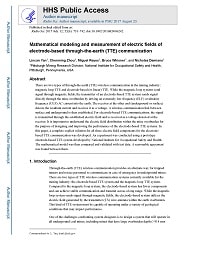Mining Publication: Mathematical Modeling and Measurement of Electric Fields of Electrode-Based Through-the-Earth (TTE) Communication
Original creation date: June 2017
Authors: L Yan, C Zhou, M Reyes, B Whisner, N Damiano
There are two types of through-the-earth (TTE) wireless communication in the mining industry: magnetic loop TTE and electrode-based (or linear) TTE. While the magnetic loop systems send signal through magnetic fields, the transmitter of an electrode-based TTE system sends signal directly through the mine overburden by driving an extremely low frequency (ELF) or ultralow frequency (ULF) AC current into the earth. The receiver at the other end (underground or surface) detects the resultant current and receives it as a voltage. A wireless communication link between surface and underground is then established. For electrode-based TTE communications, the signal is transmitted through the established electric field and is received as a voltage detected at the receiver. It is important to understand the electric field distribution within the mine overburden for the purpose of designing and improving the performance of the electrode-based TTE systems. In this paper, a complete explicit solution for all three electric field components for the electrode-based TTE communication was developed. An experiment was conducted using a prototype electrode-based TTE system developed by National Institute for Occupational Safety and Health. The mathematical model was then compared and validated with test data. A reasonable agreement was found between them.

- Above-the-Earth Field Contours for a Dipole Buried in a Homogeneous Half-Space
- Adaptive-Noise-Cancellation Techniques for Through-the-Earth Electromagnetics: Volume III
- Degasification System Selection for U.S. Longwall Mines Using an Expert Classification System
- Effects of Weak Bands on Pillar Stability in Stone Mines: Field Observations and Numerical Model Assessment
- Elastic and Shear Moduli of Coal Measure Rocks Derived from Basic Well Logs Using Fractal Statistics and Radial Basis Functions
- Pillar Strength and Design Methodology for Stone Mines
- Stochastic Modeling of Gob Gas Venthole Production Performances in Active and Completed Longwall Panels of Coal Mines
- Through-The-Earth Wireless Real-Time Two-Way Voice Communications
- Two-Way, Through-the-Earth Emergency Communication System for Trapped Miners and the Surface
- Ultra-Low Frequency Through-the-Earth Communication Technology